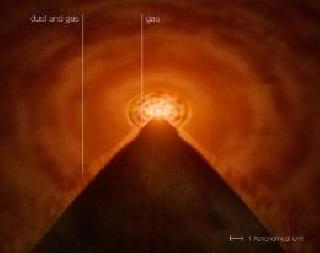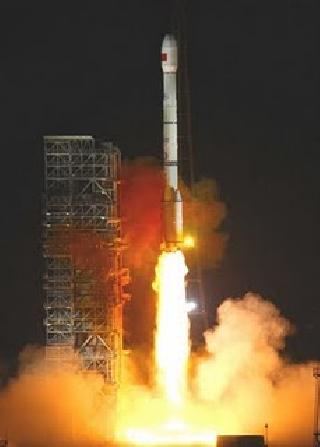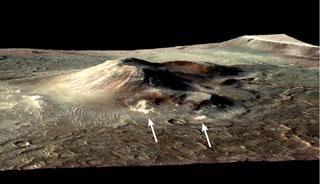
Artist's impression of the disc of matter surrounding the young stellar object MWC 147 as inferred from observations made with the European Southern Observatory's Very Large Telescope Interferometer. Photo: ESO.
AMSTERDAM (BNS): Research by two Master's students from the University of Amsterdam's (UvA) Anton Pannekoek Astronomical Institute (IAP), has offered new insight into the structure of the gaseous and dust disc around a so-called 'Herbig Be' star, as reported in the university news release.
Students Rik van Lieshout and Tullio Bagnoli performed measurements at the observatory on La Palma (Canary Islands).
They studied the Herbig Be star MWC 147, a very young, newly formed star in the transitional stage between massive and less massive stars. The mass of this star is approximately six times the mass of the Sun.
The students did this for the Observation Project, part of the UvA's Astronomy and Astrophysics Master's study programme. They wanted to answer whether stars much heavier than the Sun are able to form planets, added the release.
Herbig Be stars are surrounded by a disk with gaseous and solid particles. The measurements, which Van Lieshout and Bagnoli made with the Belgian Mercator telescope, offer new insight into the structure of the gaseous and dust disc near the star, at a spatial scale much smaller than the orbit of Mercury around the Sun. Planets could possibly be formed in the aforementioned disc.
With the help of the telescope, the students could describe the physical properties of the gaseous and dust disc, including the geometry and surface brightness.
The inner disc is flat and appears to pass close the star surface, while the outer disk is much thicker and has a conical shape (the shape of a horn). The inner disc consists entirely of gaseous, due to the high temperature as a result of proximity to MWC 147 (too hot for dust particles). The transition between these two parts of the disk is consistent with earlier findings.
The formation of rocky planets through the accumulation of dust grains does not seem possible in the inner flat portion of the disk around MWC 147 because no dust grains can exist there.
The dimensions of this flat portion of the disc roughly correspond to the distance between the Sun and Mars in our solar system. A better understanding of planet formation may lead to greater understanding of the formation of our solar system. This requires mapping out the structure of the gaseous and dust disc (the protoplanetary disc, where planets may come into being) from other stars, concluded the report.
The students were accompanied by Prof. Rens Waters (Professor of Astronomy at the University of Amsterdam and Scientific Director of SRON Netherlands Institute for Space Research) and Gerrit van der Plas and Daan Meerburg (both PhD students at the UvA's IAP).
 Previous Article
Previous Article Next Article
Next Article











The Indian Air Force, in its flight trials evaluation report submitted before the Defence Ministry l..
view articleAn insight into the Medium Multi-Role Combat Aircraft competition...
view articleSky enthusiasts can now spot the International Space Station (ISS) commanded by Indian-American astr..
view article